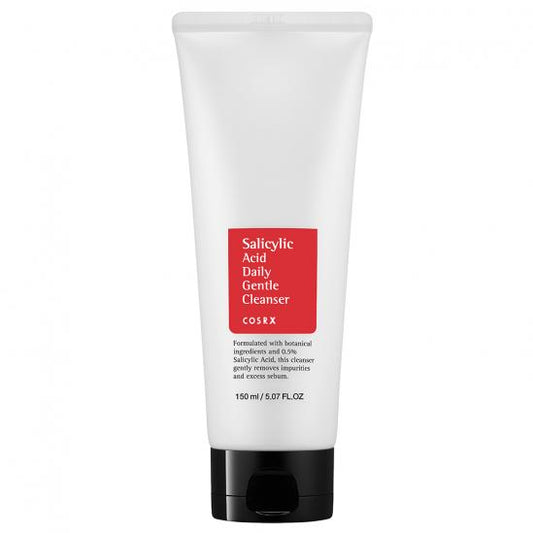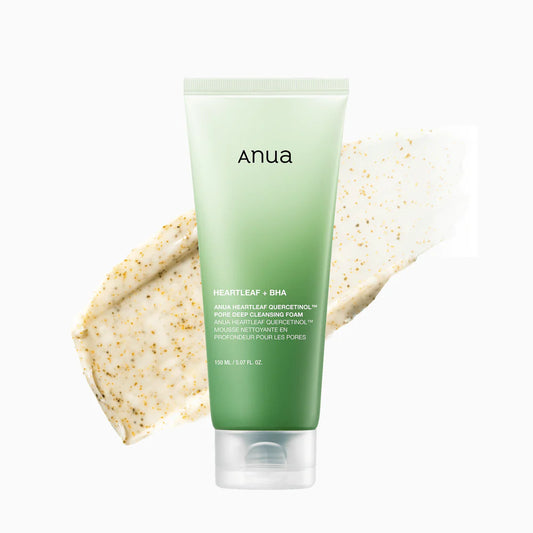
Regardless of your skin type, regular exfoliation is essential for maintaining a fresh and healthy complexion. Read the full article to understand why you should exfoliate your skin, the different exfoliation methods, and how to choose the right product for your skin type and concerns.
What is Exfoliation?
Exfoliation is the process of removing dead skin cells and accumulated impurities from the outer layer of the skin – the epidermis.
You can use either a chemical or physical exfoliation method (more on them below) to eliminate old cells. This prevents clogged pores and reveals the fresher, healthier skin underneath.
Exfoliation supports the skin's natural cell renewal process. This process begins in the deepest layer of the epidermis, where fresh cells are "born." These young, elastic cells move upward through the other layers of the epidermis until they reach the skin’s surface. Once they reach this point and settle, the cells that were once new and elastic become dead, dry, and flaky. Meanwhile, a new batch of fresh cells is making its way from the deeper layers to the surface to replace the dead, dry cells.
Skin cell turnover is a natural process but slows down with age. In healthy, young skin, this process typically occurs every 28 days. However, as we age, it takes much longer—anywhere from 40 to 60 days or more. Slower renewal leads to skin issues, including dullness, uneven tone, and breakouts due to clogged pores.
Best Exfoliating Ingredients
The best exfoliating ingredients are those that gently remove dead skin cells without compromising skin health. While the ideal choice varies based on skin type, we recommend:
-
Glycolic acid (AHA)
-
Lactic acid (AHA)
-
Salicylic acid (BHA)
-
Fruit enzymes
-
Bamboo extract
-
Jojoba beads
But more on them later!

Benefits of Exfoliation
Helps Clear Congested Skin by Unclogging Pores
The longer dead skin cells remain on the surface, the higher the risk of clogged pores and congestion.
Along with excess oil and debris, dead skin cells can easily become trapped in pores, creating an ideal environment for bacteria to thrive. This can lead to acne-related issues, from mild blackheads and pimples to severe cysts and nodules.
One of the best ways to combat congested skin is through regular, gentle exfoliation.
Exfoliation removes dead skin cells and unclogs pores, keeping them clean. This minimizes the likelihood of acne-causing bacteria developing in the pores and triggering breakouts.
May Minimize the Appearance of Fine Lines and Wrinkles
Exfoliation won’t eliminate fine lines and wrinkles, but it can help reduce their appearance. By removing the top layer of dead skin, your skin appears smoother, making fine lines less noticeable.
Promotes a Brighter and More Even Skin Tone
A dull complexion often results from a buildup of dead skin cells. Removing these cells can instantly make your skin appear brighter and fresher. Over time, consistent exfoliation can help even out skin tone and minimize the appearance of hyperpigmentation.
Allows Skincare Products to Penetrate Deeper
One lesser-known benefit of exfoliation is its ability to enhance the absorption of skincare products. Without a layer of dead cells blocking the way, serums, moisturizers, and masks can penetrate deeper into the skin. If a product is rich in nourishing and active ingredients, better absorption means better results!

How to Exfoliate – Chemical vs. Physical Methods
There are two main types of exfoliation – physical and chemical.
Both share the same goals: clearing away dead skin cells, promoting cell turnover, and leaving the skin brighter and smoother. However, they achieve this in different ways.
To choose the best exfoliant for your skin type and concerns, it’s important to understand how each method works.
Physical Exfoliation
Physical exfoliants contain small particles like coffee, jojoba beads, or sugar granules. These require manual application and gentle rubbing to remove dead skin cells.
Other examples of physical exfoliation include microdermabrasion treatments and textured facial gloves or cloths that slough away dead skin and impurities.
If you choose a facial scrub, avoid harsh ingredients like crushed fruit pits or nut shells unless they are finely milled. Larger particles can be too abrasive, causing micro-tears in the skin and damaging the skin barrier.
Chemical Exfoliation
Other facial exfoliants fall into the category of chemical exfoliants, which include AHAs (alpha hydroxy acids), BHAs (beta hydroxy acids), and fruit enzymes.
Don’t let the word "acid" intimidate you—these ingredients can be incredibly beneficial for your skin. Instead of relying on physical motion to remove dead cells, acids dissolve the “glue” that holds dead cells together, allowing them to loosen and shed naturally.
Common types of acids and enzymes include:
-
Glycolic Acid (AHA): A natural exfoliant found in plants like sugarcane and citrus fruits.
-
Lactic Acid (AHA): A gentler yet effective exfoliant, perfect for sensitive skin.
-
Salicylic Acid (BHA): Oil-soluble and capable of penetrating deeper into the pores to remove built-up sebum and impurities.
-
Fruit Enzymes: Break down keratin proteins that attach to dead cells, revealing fresher, brighter skin.
Which Method is Right for You?
Depending on your skin type and concerns, you can choose a physical exfoliant, a chemical exfoliant, or a combination of both.
Physical Exfoliation
As mentioned earlier, the best physical exfoliants contain fine, non-abrasive particles that won’t harm your skin.
Physical exfoliants can also be combined with fruit enzymes in skincare formulas for a gentle yet effective way to remove dead skin cells.
For sensitive, dry, or mature skin:
-
Bamboo extract has mild exfoliating properties that encourage cell renewal and reveal softer, younger-looking skin. It’s ideal for compromised or sensitive skin barriers, acne-prone, and dry skin.
-
Jojoba beads and rice powder are also effective yet gentle options for skin types needing extra care during exfoliation.
We recommend Veracova’s Gentle Exfoliating Face Gel with bamboo fibers to purify and brighten your skin.
For normal/combination skin:
-
Icelandic volcanic sand is a soft exfoliant that gently renews the skin’s outer layer for a refreshed complexion.
For oily, acne-prone skin:
-
Extremely fine Polynesian sand provides gentle exfoliation, helping to clear clogged pores and promote a cleaner complexion for oily skin.
Chemical Exfoliation
For Normal/Combination Skin
Glycolic acid holds the title for having the smallest molecular structure among AHAs. This means your skin absorbs it quickly, making it work faster than other AHAs. Additionally, it has water-attracting properties and can help treat uneven skin tone, reduce the appearance of pores, and combat fine lines and acne scars.
For Sensitive, Dry, and Mature Skin
Lactic acid (AHA) is a great all-rounder but serves as a gentler exfoliant choice for sensitive and mature skin. It detoxifies and hydrates more than glycolic acid while also removing dead skin cells to reveal a radiant, smoother complexion.
We recommend the Lactic Acid Serum by MG Skincare, which has an exfoliating effect and helps with acne, scars, signs of aging, and various types of pigmentation.
For Oily, Acne-Prone Skin
Salicylic acid (BHA) has anti-inflammatory and antibacterial properties, making it an effective choice if your skin is prone to acne and breakouts.

How Often Should You Exfoliate?
It's important to listen to your skin to determine how often you should exfoliate, but we can provide some general guidelines.
- Normal and oily skin can typically handle gentle exfoliation 1-3 times per week. If you're using a stronger exfoliant, reduce it to once a week.
- Sensitive or dry skin should stick to a mild exfoliation session once a week.
The Dangers of Over-Exfoliation
Always pay attention to how your skin reacts to exfoliation. It's easy to overdo it, and excessive exfoliation can lead to skin issues.
If your face develops red, flaky, or dry patches or starts to look "waxy," it may be a sign that the exfoliant is too strong for your skin type or that you're using it too frequently.
Over-exfoliation weakens the skin barrier. It strips away natural oils, which can result in dehydration, broken capillaries, and acne.
Your skin may also become more sensitive to other skincare products that previously didn’t cause any issues.
Start Your Exfoliation Routine
Ready to refresh your skin with gentle, cruelty-free exfoliating ingredients? Explore our exfoliating skincare products.



